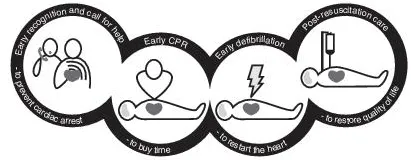
- English
- ePUB (mobile friendly)
- Available on iOS & Android
About this book
In the event of an adult cardiac arrest, it is essential to be able to respond rapidly, providing safe and effective care. This new and updated edition of Advanced Cardiac Life Support provides the theoretical background to resuscitation as well as explaining the essential resuscitation skills required to manage an adult cardiac arrest- from the time it occurs until subsequent transfer to the ICU.
The emphasis is on the prevention of cardiac arrest with detailed information on the management of peri-arrest arrhythmias and acute coronary syndromes. Advanced Cardiac Life Support also discusses ethical and legal issues, record keeping, dealing with bereavement, audit, equipment and training- providing an essential quick reference tool for nurses and health care professionals.
- An evidence-based approach to emergency care based on the latest Resuscitation guidelines
- A succinct yet comprehensive guide to the management of cardiac arrest
- Written by an experienced resuscitation training offer who is also a qualified nurse and former CCU Charge Nurse
Frequently asked questions
- Essential is ideal for learners and professionals who enjoy exploring a wide range of subjects. Access the Essential Library with 800,000+ trusted titles and best-sellers across business, personal growth, and the humanities. Includes unlimited reading time and Standard Read Aloud voice.
- Complete: Perfect for advanced learners and researchers needing full, unrestricted access. Unlock 1.4M+ books across hundreds of subjects, including academic and specialized titles. The Complete Plan also includes advanced features like Premium Read Aloud and Research Assistant.
Please note we cannot support devices running on iOS 13 and Android 7 or earlier. Learn more about using the app.
Information
Chapter 1
Resuscitation Service: An Overview
Introduction
Learning outcomes
- Discuss the concept of the chain of survival
- Summarise Cardiopulmonary Resuscitation: Standards for Clinical Practice and Training
- Discuss the key recommendations in the joint statement
- Discuss the principles of safer handling during cardiopulmonary resuscitation (CPR)
Concept of the chain of survival

- Early recognition and call for help to prevent cardiac arrest: this link stresses the importance of recognising patients at risk of cardiac arrest, calling for help and providing effective treatment to hopefully prevent cardiac arrest; up to 80% of patients sustaining an in-hospital cardiac arrest have displayed signs of deterioration prior to collapse (Nolan et al., 2006); most patients sustaining an out-of-hospital cardiac arrest also display warning symptoms for a significant duration before the event (Muller et al., 2006)
- Early CPR to buy time and early defibrillation to restart the heart: the two central links in the chain stress the importance of linking CPR and defibrillation as essential components of early resuscitation in an attempt to restore life
- Post-resuscitation care to restore quality of life: the priority is to preserve cerebral and myocardial function, to restore quality of life and indicates the potential benefit that may be provided by therapeutic hypothermia
Cardiopulmonary Resuscitation: Standards for Clinical Practice and Training
- The resuscitation committee
- The resuscitation officer
- Resuscitation training
- Prevention of cardiopulmonary arrest
- The resuscitation team
- Resuscitation in children, pregnancy and trauma
- Resuscitation equipment
- Decisions relating to CPR
- Patient transfer and post-resuscitation care
- Audit and reporting standards
- Research
Key recommendations in the joint statement
Resuscitation committee
- A physician
- A senior resuscitation officer
- An anaesthetist/intensivist
- A senior manager
- Representatives from appropriate departments, for example, accident and emergency (A&E), paediatrics, based on local needs
- Advising on the composition and role of the resuscitation team
- Ensuring that resuscitation equipment and resuscitation drugs are available
- Ensuring the adequate provision of resuscitation training
- Ensuring that Resuscitation Council (UK) guidelines and standards for resuscitation are followed
- Updating resuscitation and anaphylaxis policies
- Recording and reporting clinical incidents related to resuscitation
- Auditing resuscitation attempts and do not attempt resuscitation (DNAR) orders
Resuscitation officer
- Implementing Resuscitation Council (UK) guidelines and standards in resuscitation
- Providing adequate resuscitation training for relevant hospital personnel
- Ensuring there are systems in place for checking and maintaining resuscitation equipment
- Auditing resuscitation attempts using the current Utstein template
- Attending resuscitation attempts and providing feedback to team members
- Coordinating participation in resuscitation-related trials
- Keeping abreast of current resuscitation guidelines
Resuscitation training
Prevention of cardiopulmonary arrest
The resuscitation team
- Airway management (including tracheal intubation)
- Intravenous cannulation (including central venous access)
- Defibrillation (advisory and manual) and electrical cardioversion
- Drug administration
- Advanced techniques, e.g. external cardiac pacing and pericardiocentesis
- Appropriate skills for effective post-resuscitation care
- Directing and coordinating the resuscitation attempt
- Ensuring the safety of the patient and the team
- Terminating the resuscitation attempt when indicated
- Communicating with the patient’s relatives and other healthcare professionals
- Documenting the resuscitation attempt (including audit forms)
Resuscitation in children, pregnancy and trauma
Table of contents
- Cover
- Contents
- Title Page
- Copyright
- Acknowledgements
- Chapter 1: Resuscitation Service: An Overview
- Chapter 2: Resuscitation Equipment
- Chapter 3: Recognition and Treatment of the Critically Ill Patient
- Chapter 4: Principles of Cardiac Monitoring and ECG Recognition
- Chapter 5: Bystander Basic Life Support
- Chapter 6: Airway Management and Ventilation
- Chapter 7: Defibrillation and Electrical Cardioversion
- Chapter 8: Advanced Life Support
- Chapter 9: Resuscitation in Special Situations
- Chapter 10: Anaphylaxis
- Chapter 11: Acute Coronary Syndromes
- Chapter 12: Management of Peri-Arrest Arrhythmias
- Chapter 13: Post-Resuscitation Care
- Chapter 14: Bereavement
- Chapter 15: Ethical Issues in Resuscitation
- Chapter 16: Resuscitation Records
- Chapter 17: Resuscitation Training
- Index